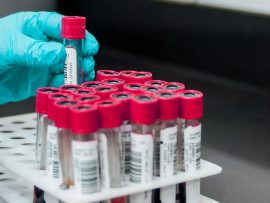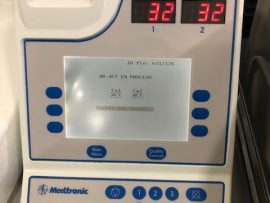Abstract Introduction Viscoelastic point-of-care diagnostics are crucial in cardiac surgery. In the FIBTEM assay of rotational thromboelastometry (ROTEM), guidelines suggest target maximum clot firmness values to reduce perioperative bleeding. The..
Read MoreAbstract Transfusion management during cardiac surgery is commonly guided by algorithms using viscoelastic tests such as Rotational Thromboelastometry (ROTEM). Recently, the ROTEM Sigma, a new device developed as a fully..
Read MoreAbstract Background: Monitoring the anticoagulant effect of unfractionated heparin (UFH) in extracorporeal membrane oxygenation (ECMO) patients is complex but critically important to balance the risks of treatment related bleeding and..
Read MoreAbstract Objectives To investigate the effect of retrograde autologous priming (RAP) on coagulation function using rotation thromboelastometry (ROTEM) in patients undergoing valvular cardiac surgery. Design A prospective, randomized, patient- and outcome assessor-blinded study...
Read MoreAbstract Objectives Viscoelastic assays, such as rotational (ROTEM), are used increasingly in cardiac surgery to guide transfusion decisions. After separation from (CPB), achieving rapidly is the main goal before chest closure. The authors hypothesized..
Read MoreAbstract Introduction We hypothesized that perioperative fibrinogen level, platelet count, and rotational thromboelastometry (ROTEM) data values decrease in proportion to cardiopulmonary bypass (CPB) time, particularly in patients who underwent deep..
Read MoreAbstract Introduction: We aimed to investigate parameters for prediction of post-operative blood loss and re-operation in patients who underwent cardiopulmonary bypass. Methods: Thrombin generation assay, activated partial thromboplastin time, activated clotting time..
Read MoreAbstract Background: We aimed to evaluate the effect of third-generation hydroxyethyl starch (6% HES 130/0.4) on hemostasis and perioperative blood loss in patients undergoing off-pump coronary artery bypass (OPCAB) with..
Read MoreAbstract The clinical importance of viscoelastic testing in patient blood management when performing cardiovascular surgery is increasing. We aimed to examine the effect of a blood transfusion protocol including an..
Read MoreAbstract Background Each year in the UK, ≈3000 children undergo major cardiac surgery requiring cardiopulmonary bypass. Approximately 40 % of these experience excessive bleeding necessitating red cell transfusion or treatment with..
Read MoreAbstract This retrospective, observational study compared the impact of a point-of-care rotational thromboelastometry (ROTEM®) method versus conventional bleeding management in terms of postoperative (24-h) blood loss, intraoperative and postoperative (24-h)..
Read MoreAbstract Optimal anticoagulation monitoring in patients with extracorporeal membrane oxygenation (ECMO) is fundamental to avoid hemorrhagic and thromboembolic complications. Besides conventional coagulation tests, there is growing interest in the use..
Read MoreAbstract In thromboelastometry (ROTEMTM) the difference in amplitude between the EXTEM and the FIBTEM is considered an index of platelet contribution to clot strength (PCSamp). The difference in elasticity (PCSel)..
Read MoreSummary Thromboelastometry point‐of‐care coagulation testing facilitates optimised management of bleeding. Previous thromboelastometry systems required the blood sample and liquid reagents to be pipetted in several manual steps by trained personnel...
Read MoreAbstract Objectives Rotational (ROTEM)-guided transfusion algorithms in cardiac surgery have been proven to be successful in reducing blood loss in randomized controlled trials. Using an institutional registry of patients in cardiac surgery..
Read MoreAbstract Background Acute normovolemic hemodilution is recommended as a technique to reduce allogeneic red blood cell (RBC) transfusions in cardiac surgery, but its efficacy to reduce non‐RBC transfusion has not..
Read MoreAbstract Background: The aim of the present study was to investigate the relationship between maximum clot firmness (MCF) in rotational thromboelastometry (ROTEM®) and postoperative bleeding in patients on clopidogrel after..
Read MoreObjective The aim was to evaluate the predictive value of for in adult cardiac surgery with . Design Retrospective and systematic review of the literature. Setting A tertiary university hospital. Participants 202 patients undergoing..
Read MoreAbstract Summary Development and standardization of fibrinolysis methods have progressed more slowly than coagulation testing and routine high‐throughput screening tests for fibrinolysis are still lacking. In laboratory research, a variety..
Read More






